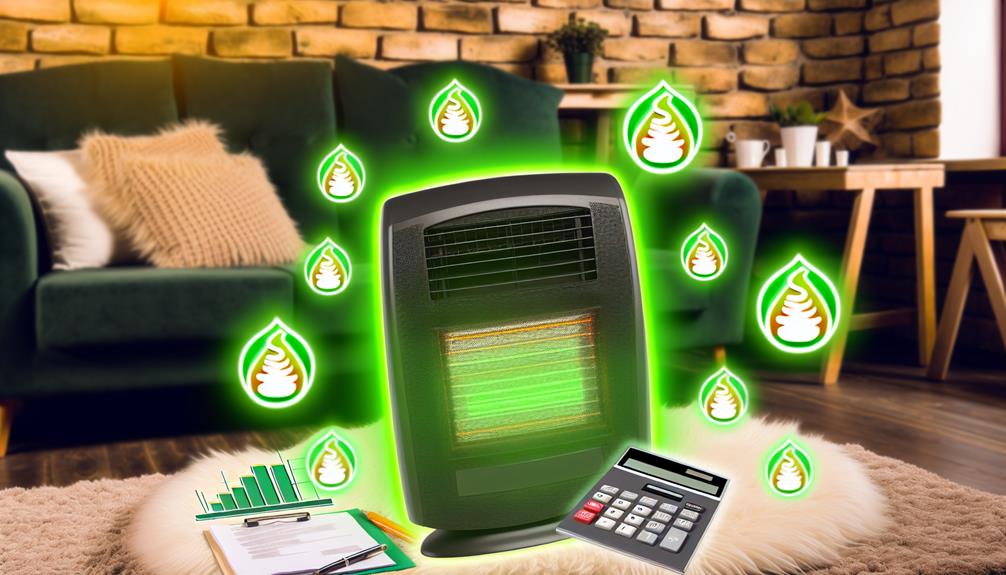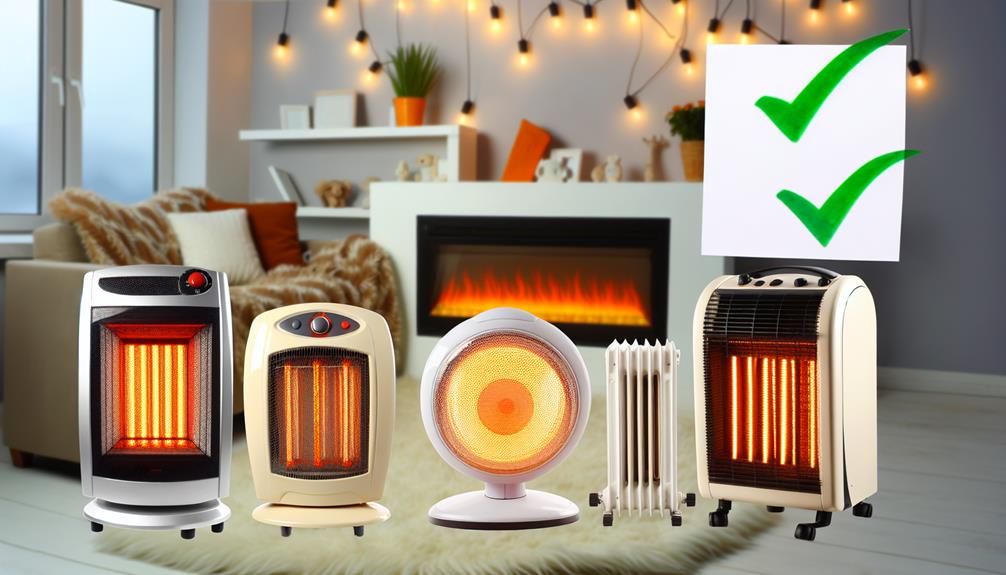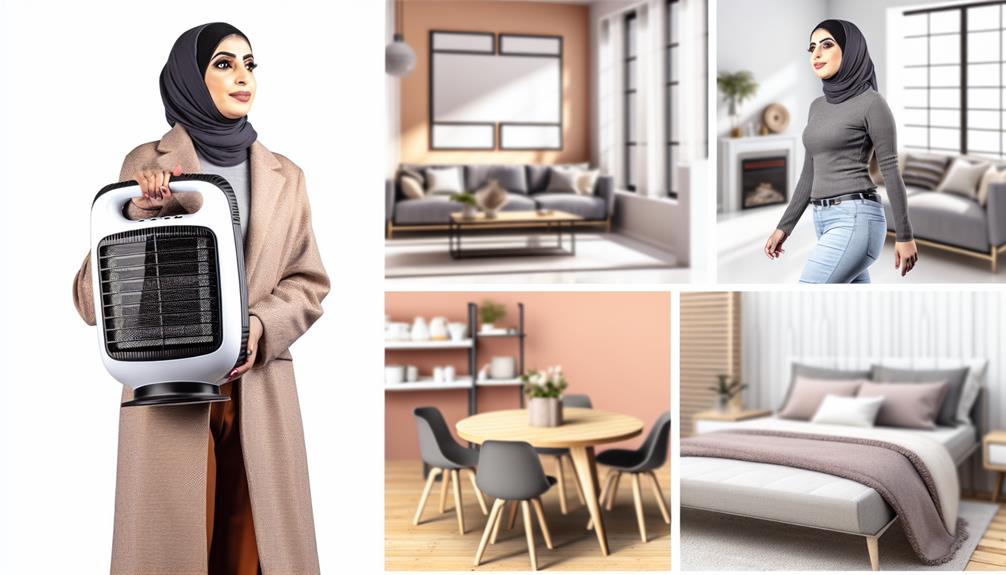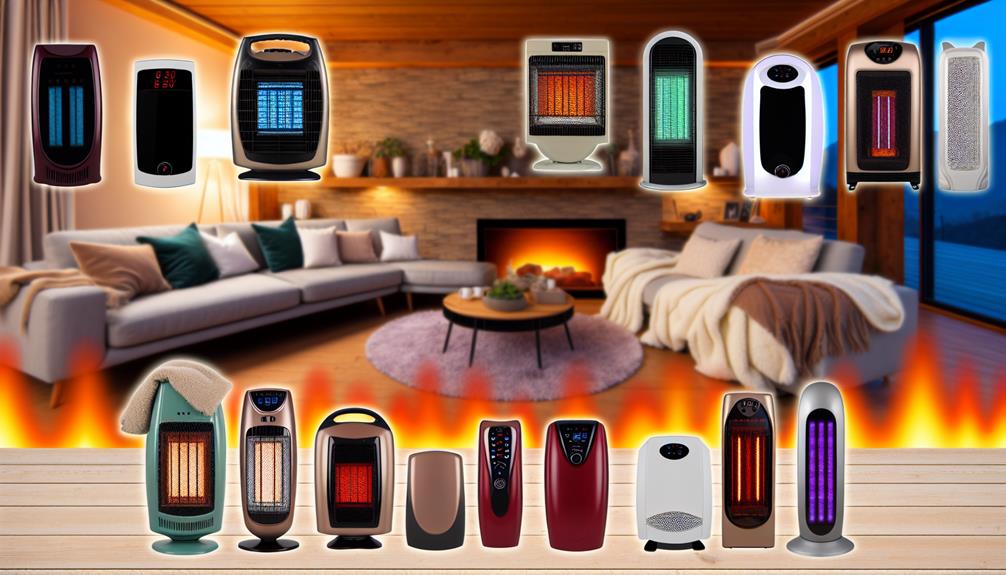As winter's chill creeps in, the warmth of a portable heater becomes a comfort you can't afford to choose hastily, yet the overwhelming array of options can leave you cold with indecision. You're facing a market brimming with devices that promise to turn your frosty mornings into a snug retreat, but not all heaters are created equal. You need a checklist that serves as your beacon through the fog of specifications and features. Consider this your guide to navigating the intricacies of wattage, safety standards, and energy efficiency, ensuring you find a heater that not only toasts your toes but also aligns with your living space and lifestyle. Stay tuned, as you're about to uncover the key elements that will equip you with the knowledge to select a portable heater that offers the best blend of comfort, cost, and convenience.
Key Takeaways
- Consider the different types of heaters available, such as convection, radiant, fan-forced, and wall heaters, and choose the one that best suits your needs and preferences.
- Prioritize heater safety by looking for advanced safety features like overheat and tip-over protection switches, as well as certification labels from recognized testing laboratories.
- Determine the appropriate size and capacity of the heater by allocating about 10 watts of heating power per square foot of space and considering high ceilings.
- Evaluate the energy efficiency of the heater by looking for Energy Star ratings, considering lower wattage models, and examining energy efficiency ratings in watts per hour.
Assessing Heater Types
When selecting a portable heater, it's crucial to understand the different types available, as each has specific characteristics suited to varying needs and room sizes. Convection heaters are ideal for whole-room heating. They operate quietly, using heating elements to warm the air, which then circulates naturally throughout the space. This type of supplemental heating is best for consistent, long-term use.
Radiant heaters, or infrared heaters, differ by directly warming objects and people in their path. They offer quick warmth, making them perfect for spot heating or rooms where you'll remain in one place for a while.
Fan-forced heaters use a fan to blow air across a heated element. As a result, they distribute heated air more evenly throughout a room. These portable heaters can quickly raise the temperature in your space, but they may produce more noise due to the fan.
Wall heaters are a more permanent type of space heater, mounted on a wall, and are an efficient way to address under-heated rooms without taking up floor space.
When assessing the heater for your needs, consider heating power. A space heater buying guide can provide sizing recommendations based on wattage and square footage. Also, don't overlook safety features, as these are paramount in preventing accidents and ensuring safe operation.
Determining Size and Capacity
How do you choose the right size and capacity for your portable heater to ensure it effectively warms your intended space? The key is to consider the square footage of the area you're heating. A general rule is to allocate about 10 watts of heating power per square foot of space. So, a 1500-watt heater typically covers about 150 square feet, effectively raising the room temperature.
Now, let's break down the specifics with a table that correlates wattage and square footage for common room sizes:
| Room Size (feet) | Heater Wattage |
|---|---|
| 10 x 12 room | 1200 watts |
| 12 x 15 room | 1800 watts |
| 15 x 20 room | 3000 watts |
When you're selecting a type of space heater, remember that they come in a variety of sizes and heating capacities. A larger space heater may be necessary for rooms with high ceilings since the cubic feet of space to be heated will be significantly more. Always ensure that the heater from room to room is suited to the particular square footage and that the wattage provides enough warmth without being excessive. Overheating can be as uncomfortable as a chilly room, and it's not energy efficient.
Evaluating Energy Efficiency

As you consider purchasing a portable heater, it's crucial to understand Energy Star ratings, which indicate the energy efficiency of various models. Comparing the wattage costs of heaters can provide insight into long-term savings on your energy bills. Pay attention to models with lower wattage that still offer effective heating, as they can be more cost-efficient over time.
Understanding Energy Star Ratings
Ensure your portable heater's efficiency by seeking out the Energy Star label, which signifies compliance with stringent energy efficiency standards established by the EPA and DOE. This means the heater uses the latest technologies to maximize heating power while minimizing energy consumption.
- Slash your energy bill: Energy Star-rated heaters can significantly lower heating costs.
- Maximize heating power: Get more warmth with fewer watts of heating power.
- Eco-friendly heating: Choosing a heater with this label helps reduce your carbon footprint.
- Durability and performance: Heaters with Energy Star Ratings tend to use quality components, ensuring a reliable heating element that lasts.
When following this Space Heater Buying Guide, remember that heating using one of these certified heaters is a smart move that helps heat the air efficiently and cost-effectively.
Comparing Heater Wattage Costs
While selecting a heater with an Energy Star rating is a smart choice for efficiency, you'll also want to compare the wattage costs to find the most cost-effective model for your needs. Sizing by wattage is crucial; determine the appropriate wattage to effectively heat your space without excess electric power consumption. Evaluate the cost per kilowatt-hour in your area and calculate the potential utility costs associated with different wattages. Heaters with a lower number of heating elements may consume less energy while still producing sufficient warm air. Conversely, a high-wattage unit might provide more heated air but could lead to higher long-term expenses. By using one with a balanced heat output to wattage ratio, you can optimize energy efficiency and reduce costs.
Understanding Safety Features
You'll significantly reduce the risk of fire and overheating incidents with a portable heater equipped with advanced safety features such as overheat and tip-over protection switches. When buying a space heater, prioritizing heater safety is crucial to ensure that your choice serves as a reliable source of primary heat without compromising your well-being.
Choosing the best space heater means looking for models that are certified by a recognized testing laboratory. This certification indicates that the heater has been tested and deemed safe for use. Always consult the owner's manual to understand the proper power cord placement and to address any specific questions you might have about the operation of your heater.
Here are some key safety features to look for that can evoke a sense of security:
- Overheat Protection Switch: Automatically shuts off the heater if internal components reach an unsafe temperature.
- Tip-Over Protection Switch: Cuts power if the heater is accidentally knocked over.
- Cool-to-the-Touch Exterior: Minimizes burn risks, especially important in homes with children or pets.
- Certification Labels: Look for labels from recognized testing laboratories confirming the heater has met strict safety standards.
Considering Heating Technology

You'll need to assess the types of heating elements available, as each technology impacts the heater's performance in your space. Consider convection heaters for consistent room heating, or opt for radiant heaters for immediate warmth. Don't overlook energy efficiency ratings; they're crucial for long-term savings and environmental impact.
Types of Heating Elements
When selecting a portable heater, it's crucial to understand the different types of heating elements available, as each employs distinct heating technology suited for various needs and preferences. Here's a concise breakdown to guide your choice:
- Convection Heaters: Ideal for heating an entire room quietly and effectively.
- Radiant/Infrared Heaters: Perfect for instant warmth, directly heating you and the objects around.
- Fan-forced Heaters: Employ a blower fan to distribute heat evenly, quickly warming up your space.
- Oil-filled Heaters: Offer consistent heat without the dryness, mimicking the effect of baseboard heaters.
Choose a space heater with the right heating element to ensure your room is enveloped in comfort. Remember, how heaters work varies, so pick one that aligns with your desired comfort and the room's layout.
Energy Efficiency Ratings
As you consider the various heating technologies for your portable heater, it's essential to examine their energy efficiency ratings to gauge their impact on your energy consumption over time. When you use a space heater, things to consider include not just the immediate warmth but also how it can save you money in the long run. Efficiency is typically measured in watts per hour, indicating how much electricity the heater uses to warm a room.
Convection heaters, for example, are known for their efficient air circulation. Radiant or infrared heaters provide quick spot heating with direct warmth, while fan-forced heaters offer widespread comfort. Even if you opt for a wall heater for your home, ensure the power cord leads to a unit with favorable energy efficiency ratings.
Analyzing Noise Levels
To ensure your comfort isn't marred by intrusive sounds, assess the decibel rating of the portable heater before making a purchase, particularly if it's intended for use in environments where quiet is paramount. When looking for a heater, the noise level is a critical factor, especially if you're planning to use it in a space where serenity is key—like a bedroom or office.
In crafting your industrial heater buying guide, consider the following:
- Specific needs: If you're trying to warm a smaller space, a heater with low noise output is vital to maintain tranquility.
- Plan ahead: Understand the type of heater that's best for spot heating without adding auditory clutter.
- Model selection: Look for models that boast of noise-reduction features to ensure peace is preserved while you warm the area.
- Buying wisdom: Remember, the right heater should help you stay warm without disrupting your quietude.
Convection, radiant, fan-forced, and wall heaters all come with distinct noise profiles. Prioritize units designed to operate quietly, so your quest for warmth doesn't come at the cost of your comfort or concentration.
Checking Portability and Design

Ensure the portable heater you select is easy to move by checking its weight and dimensions, and looking for features like handles and wheels that enhance portability. When you're in the market for one that's both functional and easy to transport, the design plays a crucial role. Opt for a model with a foldable or compact build if you aim to stow it away conveniently when it's not warming the air.
Portable heaters come in a variety, with styles designed to work well in different environments. Assess the construction for durability—after all, the last thing you want is a heater that falls short in longevity. Also, look for smart design elements such as cord storage and carry handles to make your life easier.
Here's a quick reference table to Consider When Buying:
| Feature | Benefit |
|---|---|
| Lightweight | Simplifies movement and placement |
| Compact/Foldable | Saves space when not in use |
| Wheels/Handles | Aids in distributing air throughout a room without strain |
Industrial Heater Buying is a technical task that should not overlook the importance of portability and design. Ensure that your choice reflects a balance between aesthetics and practicality.
Comparing Cost and Value
When assessing the cost and value of portable heaters, consider not only the initial price but also the inclusion of essential safety features like overheating and tip-over sensors. These are critical for maintaining a safe indoor environment. Evaluate whether models come with a trustworthy owner's manual, providing personalized guidance for use and maintenance, which can save you trouble and expense in the long run.
To ensure you're getting the most out of your investment:
- Look for safety certifications from recognized testing laboratories; they're a mark of reliability.
- Analyze the performance-price correlation; paying more doesn't always mean better quality.
- Consider the area in square feet you need to keep warm; more powerful heaters for larger spaces can be costlier.
- Check for additional features such as programmable thermostats or remote control, which can enhance convenience and control.
Portable heaters are ideal for spreading that heat from room to room, providing flexibility to keep people warm wherever needed. When comparing wall heaters and portable ones, factor in not just the cost to purchase, but also the value of being able to customize your heating needs to your specific environment.
Exploring Additional Features

Moving beyond cost considerations, it's crucial to explore the additional features that can significantly enhance the utility and safety of portable heaters. When selecting a heater, the size of the space you need to warm is paramount. For personal space or an area occupied by one or two people, a smaller, lower-wattage unit may suffice.
Experts give you personalized guidance on the commonly used heating methods: convection and radiant heating. Each has its advantages, depending on your specific needs. Convection heaters are ideal for warming an entire room, while radiant heaters target specific areas, providing heat directly to objects and people.
To make your decision easier, consider this table of special features:
| Feature | Benefit |
|---|---|
| Thermostat | Maintains desired temperature efficiently |
| Timer | Allows pre-set operation, saving energy |
| Remote Control | Provides convenience and ease of use |
| Oscillating Function | Distributes heat evenly across the room |
These extra features offer guidance and trustworthy functionality, tailored to give you personalized guidance. When assessing your needs, remember that the right heater not only offers warmth but also ensures safety and energy efficiency. And remember, shipping is often free to the lower 48 states, adding extra value to your purchase.
Frequently Asked Questions
How Do I Choose a Portable Space Heater?
To choose a portable space heater, imagine outfitting a cabin for a winter retreat. You'll want a heater size that matches your room like a snug coat, with climate compatibility for consistent warmth. Prioritize heater safety with fail-safes, and seek energy efficiency to keep bills low. Consider noise levels for a peaceful environment, temperature control for precision, and easy maintenance. Opt for a sleek heater design from a brand with a solid reputation to ensure reliable comfort.
What Are the Checklist for Space Heaters?
When considering space heaters, prioritize safety features like auto shut-off and tip-over protection. Energy efficiency is key—look for models with high ratings. Ensure the heater size suits your space and the noise level is tolerable. Multiple heat settings and thermostat control offer flexibility, while adequate cord length and portability factors like wheels enhance convenience. Also, check maintenance needs and opt for units with a generous warranty period for peace of mind.
What Is the Most Effective Type of Portable Heater?
Imagine you've just snagged a sleek, compact convection heater. It's the most effective type for your needs, balancing heating efficiency with your local climate. It runs quietly, fits your space perfectly, and the built-in thermostat control keeps your room cozy. The design complements your decor, it's easy to move, and it ticks all boxes for safety and maintenance. This energy-efficient choice adapts to your lifestyle, ensuring warm, worry-free winters.
What Is the Best Wattage for a Portable Heater?
You'll want a portable heater that marries heating efficiency with your room size. Aim for low energy consumption while ensuring safety features are top-notch. Place your heater strategically to optimize warmth. In colder climates, higher wattage may be needed. Choose a model with acceptable noise levels, easy maintenance needs, precise thermostat control, and design aesthetics that suit your space. Remember, the ideal wattage balances comfort, efficiency, and practicality.
